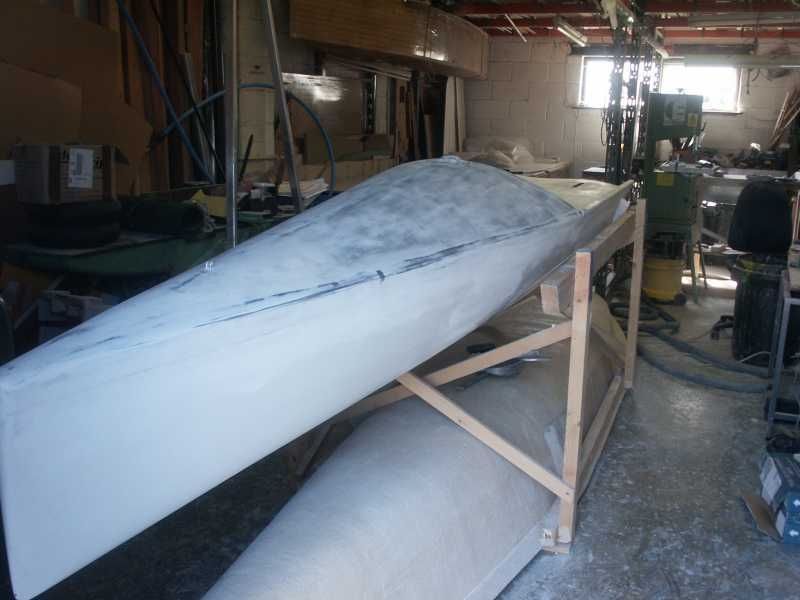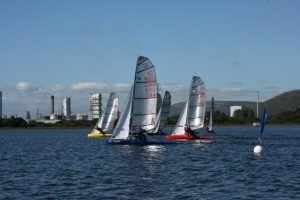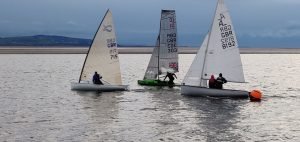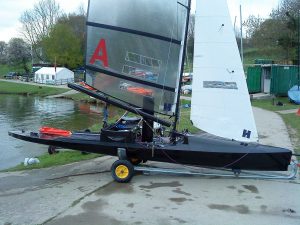Phil Morrison has a reputation of producing good looking and well behaved boats that tend to be ‘middle of the road’ rather than ‘radical’. His approach to the New Rules IC was to concentrate on changes to the hull design, recognising that the rig, foils and deck layout had been subject to constant development and refinement over the last 35 years.
Initially Phil loaded the Nethercot lines into his computer and sought to develop them taking into account his experience over the last 40 years with Int 14’s, Merlins etc. Although not as radical as some of the other new designs, it is a major change from the Nethercot. The Hull is much finer in the forward sections, and is ‘U’ shaped with flat bottom sections in the forward half of the boat to maximise buoyancy and to promote early planning. There remains a reasonable amount of rocker and the stern sections have less buoyancy to encourage the bow to lift. It is noticeable that there is less need to move the seat far aft to keep the bows out of the water, unlike some other new designs that have incorporated a “wide” stern, with an angular canoe stern.
The boat has the minimum 750mm waterline width but flares out to 880mm at deck level (cp 1060mm Nethercot) and has a higher freeboard. The reasons for this are to ensure the boat is wide enough at deck level to provide an adequate base for the shrouds to support the mast, to provide a wide enough dance floor to minimise falling over the side and in recognition that the boat would be more wave piercing than a Nethercot and it would be a good idea to keep the water out!

The height of the rear deck is the same as a Nethercot in the centre of the hull, to maintain a low Centre of Gravity when tacking and gybing with a scooped design to reflect the increased sheerline height. This also means that the seat carriage can be lower than a Nethercot. Sailing the boat with a scooped dance floor has proved to be advantageous as the leeward side provides a good foothold.
Phil Morrison considered the current sailplan efficient, and that an increased mast height would be needed to take full advantage of a una rig. Therefore the deck stepped Superspar/Orange sloop rig is the same as modern Nethercots with the mast 2m from the bow. The daggerboard is mounted further aft and is slightly narrower (225mm wide) and fits straight through a slot in the boat rather than having a cassette avoiding the need for slot gasket.

Phil advised against a ‘T’ foil (the issues with short skiffs are very different to a long thin hull) and considered the rudder located under the hull was more efficient than a transom hung rudder due to less cavitation, smaller blade and smaller turning circle.
Andy Paterson of Bloodaxe Boats on the Isle of Wight was commissioned to build the boat and invested in a female mould, therefore allowing speedier construction of further boats.
Andy and Phil Morrison have put much thought into designing the structure of the boat to keep it as light as possible. It is built with 5mm foam between carbon inner and outer skins, with extra carbon reinforcement at the high stress points. Unnecessary structure has been designed out – for example the sides of the boat (at deck level) are straight where the seat carriage tracks are located to enable the loads to be transferred directly to the hull rather through the decks first, and the main bulkhead under the mast is tied in with the rear edge of the deck along its entire length which is taken back as close as possible to the shrouds. The completed hull and deck (painted) weighed 24kg the final all-up weight was spot on the new 50kg minimum.
The new boat’s performance exceeds all expectations. Despite experiencing the inevitable teething issues at the Worlds in Melbourne in January 2008 (including the mast falling down following rigging failure) the new boat sailed to a comfortable victory in the last race. Whilst a little tippier than the Nethercot, the new design is well mannered, being easy to tack, even in waves and not experiencing any nose-diving tendency. The acceleration and responsiveness of the lightweight hull is remarkable. Initial concerns about the robustness of such a lightweight boat have also proved unfounded as the boat has withstood some punishing conditions in Hayling bay, without any problems.




